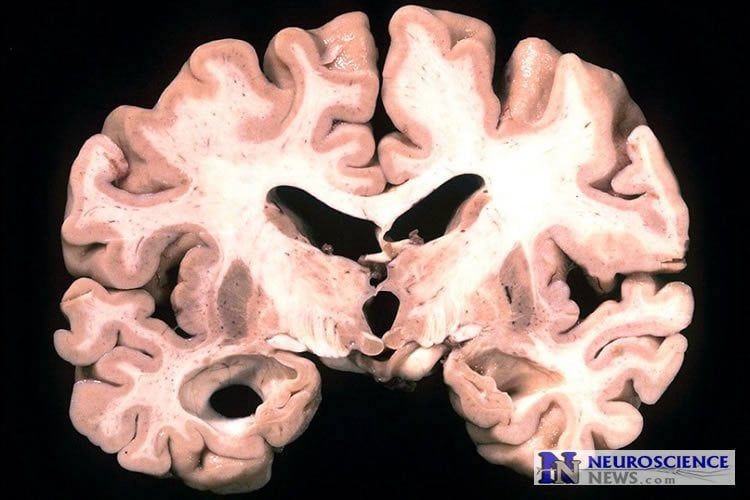Summary: A new study reports on the role the protein TDP-43 plays in the development of Alzheimer’s disease.
Source: Rush University Medical Center.
A recently-recognized pathologic protein in the brain may play a larger role in the development of clinical Alzheimer’s disease dementia than previously recognized, according to a study by researchers at Rush University Medical Center. The findings of the study of nearly 1,000 older adults were published in the Sept. 30 issue of the journal, Brain.
“This finding could help researchers to understand the cause of memory loss and lead to new ways to approach studying Alzheimer’s disease,” said Bryan James, PhD, study author and epidemiologist with the Rush Alzheimer’s Disease Center. “Our study found that when the main characteristic pathologies of Alzheimer’s disease, plaques and tangles, were mixed with a pathologic protein called TDP-43 in the brain, the combination was more likely to result in diagnosed Alzheimer’s dementia than plaques and tangles alone.”
The abnormal protein, TDP-43 (short for ‘hyperphosphorylated transactive response DNA-binding protein 43’), previously has been associated with frontal temporal dementia and amyotrophic lateral sclerosis (ALS, sometimes called Lou Gehrig’s disease). In recent years, TDP-43 also has been found in the brains of persons with other diseases, but most recently in Alzheimer’s disease.
Mixed pathologies increase Alzheimer’s risk
The hallmark pathologies of Alzheimer’s disease are the accumulation of the protein beta-amyloid (called plaques) and an abnormal form of the protein tau (called tangles). However, research from the Rush Alzheimer’s Disease Center and other groups has shown that the majority of persons with clinical Alzheimer’s dementia also develop other disease pathologies in their brains as well, such as small strokes or protein deposits called Lewy bodies.
This combination, called ‘mixed pathologies,’ increases the risk for developing diagnosed Alzheimer’s dementia above and beyond just having plaques and tangles in the brain.
“The clinical disease that we call ‘Alzheimer’s disease’ is looking more and more like the result of the accumulation of a number of disease processes in the brain of older persons,” James said. The majority of persons with diagnosed Alzheimer’s dementia actually have mixed pathologies in their brains — not just the plaques and tangles that are the known hallmarks of Alzheimer’s disease.
“In particular, mixed Alzheimer’s and TDP-43 pathologies appear to be an under-recognized yet common form of mixed pathologies that contributes to the development of clinical Alzheimer’s dementia,” James said. “This is one of the first studies to examine TDP-43 and Alzheimer’s disease in the context of mixed pathologies.”
TDP-43 found in two-thirds of those with Alzheimer’s dementia
The Brain paper built on previous research by examining whether TDP-43 was associated with an increased likelihood of a diagnosis of Alzheimer’s dementia in persons both with and without pathologic Alzheimer’s disease. The new study examined brain pathology, drawing on tissue samples from 946 deceased older men and women who had been enrolled in one of two cohort studies by the Rush Alzheimer’s Disease Center, the Rush Memory and Aging Project or the Religious Orders Study. Participants in both studies agree to donate their brains to research after their death.

TDP-43 was present in the brains of about half of the participants and in two-thirds of the brains of persons who had been diagnosed with Alzheimer’s dementia while alive. More than a third of the participants had mixed Alzheimer’s (plaques and tangles) and TDP-43 pathologies in their brain. Mixed Alzheimer’s and TDP-43 pathologies were associated with a higher likelihood of diagnosed Alzheimer’s dementia at death than plaques and tangles alone.
“These data are exciting, because an improved understanding of the TDP-43 protein has potential to guide alternative treatment strategies for Alzheimer’s disease,” James said.
Source: Nancy Difiore – Rush University Medical Center
Image Source: NeuroscienceNews.com image is in the public domain.
Original Research: The study will appear in Brain.
[cbtabs][cbtab title=”MLA”]Rush University Medical Center. “Abnormal Brain Protein May Contribute to Development of Alzheimer’s.” NeuroscienceNews. NeuroscienceNews, 30 September 2016.
<https://neurosciencenews.com/tdp-43-protein-alzheimers-5172/>.[/cbtab][cbtab title=”APA”]Rush University Medical Center. (2016, September 30). Abnormal Brain Protein May Contribute to Development of Alzheimer’s. NeuroscienceNews. Retrieved September 30, 2016 from https://neurosciencenews.com/tdp-43-protein-alzheimers-5172/[/cbtab][cbtab title=”Chicago”]Rush University Medical Center. “Abnormal Brain Protein May Contribute to Development of Alzheimer’s.” https://neurosciencenews.com/tdp-43-protein-alzheimers-5172/ (accessed September 30, 2016).[/cbtab][/cbtabs]







